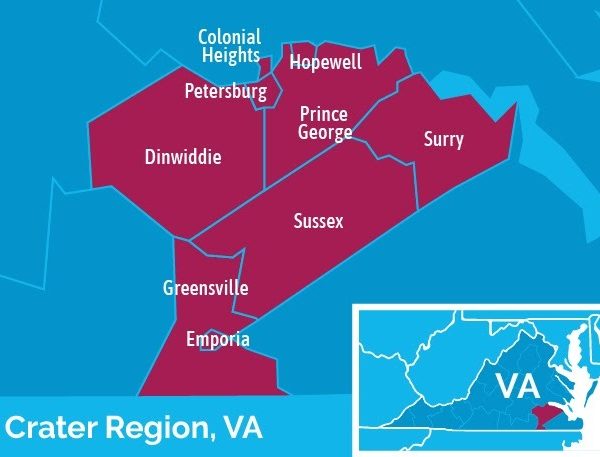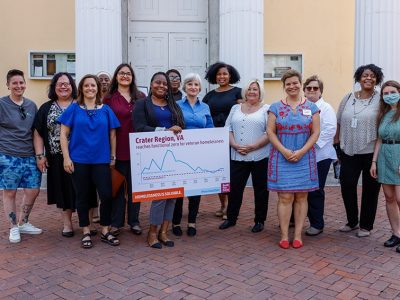COVERAGE AREA
City: 2 (Petersburg & Hopewell)
Counties: 6 (Prince George, Dinwiddie, Emporia, Greensville, Surrey & Sussex)
Total Population: 31,362
The Achievement
FUNCTIONAL ZERO FOR VETERAN HOMELESSNESS
- Milestones: Veteran (2021)
- Next Population for Focus: Chronic and youth and families
The Virginia Balance of State Continuum of Care of Petersburg — known as the “Crater Region” — joined Built for Zero in 2019. The Built for Zero Collaborative is a movement of more than more than 80 communities committed to measurably ending homelessness, one population at a time.
In February of 2021, Crater Region became the 11th community in the United States to reach functional zero for veteran homelessness, demonstrating that there are fewer veterans experiencing homelessness than can be routinely housed within a month, which is three veterans in Crater Region.
By reaching functional zero for veteran homelessness, the community has proven it has built a system that can ensure homelessness is rare and brief, even if new veterans experience housing crises over time. The community started 2020 with 16 veterans identified as experiencing homelessness, and by February reduced that number to three veterans.
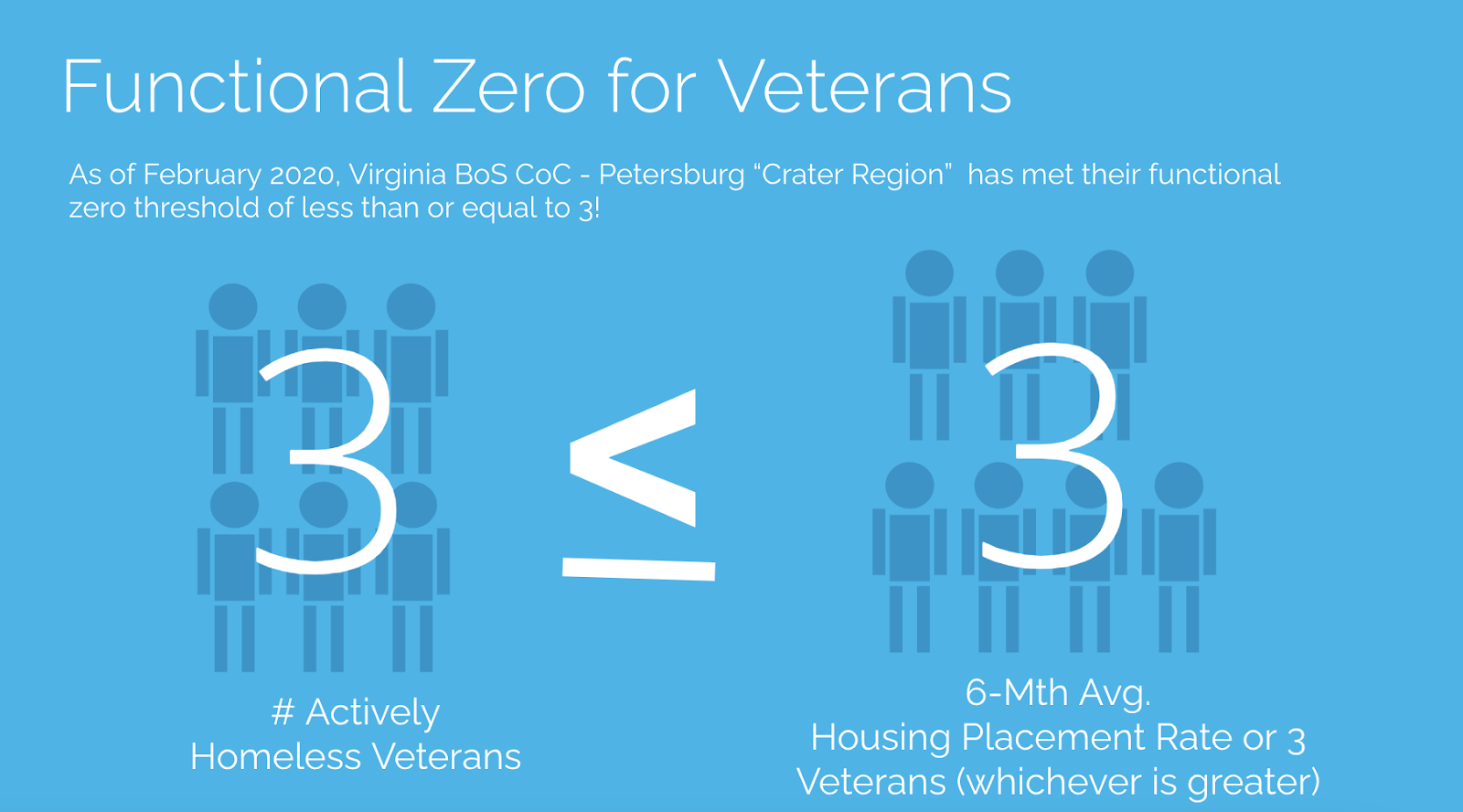
The Challenges
The Crater Region Built for Zero community faced several key challenges in their journey to reaching functional zero for veteran homelessness. These included:
- The Covid-19 pandemic. The Covid-19 crisis posed numerous health and safety threats to both clients and staff, and limited shelter capacity and prioritization.
- Need for accurate data. Not all providers working with veterans reported to the same Coordinated Entry system and there was limited staff capacity to capture and report data that would accurately reflect the overall number of actively homeless veterans.
- Need for more efficient and effective provider meetings. Improvements and tools needed to identify areas of improvement for meetings and strengthen case conferencing practices.
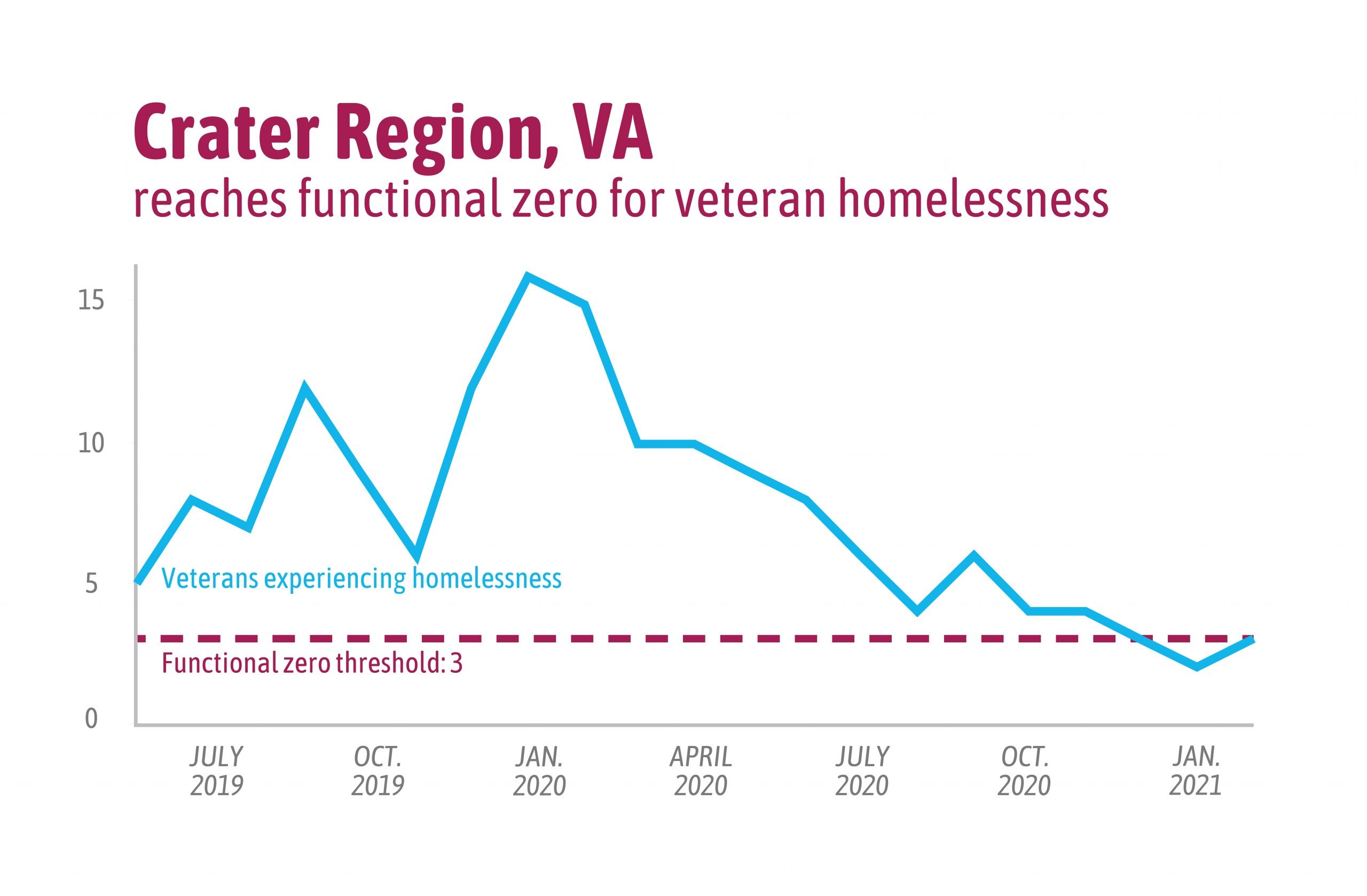
How did they do it?
As part of Built for Zero, Crater Region changed how its homeless response system works by adopting the core elements of the Built for Zero methodology:
- Building a unified regional team, or a “command center,” around a shared aim of getting to functional zero
- Using real-time, person-specific data to know every veteran experiencing homelessness by name and target efforts and resources accordingly
- Using data to redesign Crater Region’s homeless response and strategically target resources
BUILDING A COMMAND CENTER
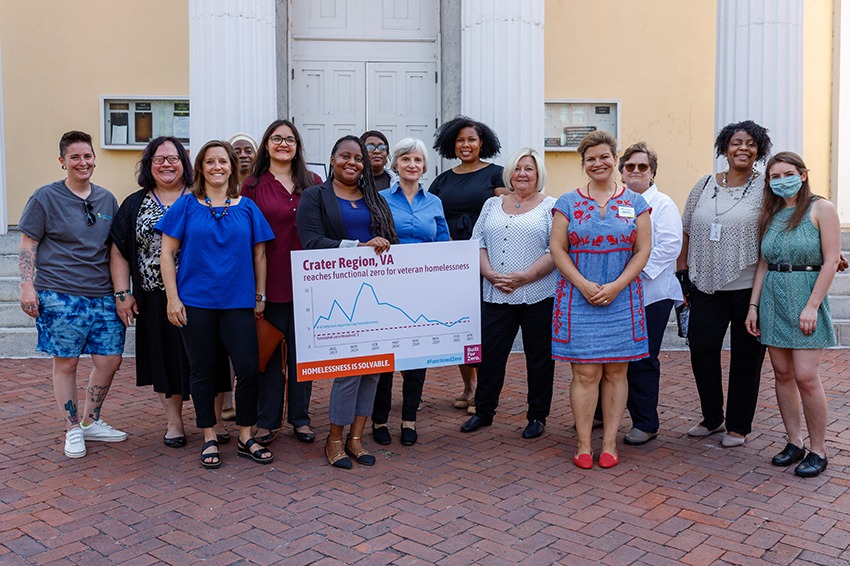
The local Built for Zero team started by unifying the efforts of key agencies working locally to end homelessness. In many communities, local agencies or nonprofits focus on their piece of the solution, without an ability to see how all the pieces in their community fit together. Often, success is defined by each organization’s programmatic goals rather than whether the overall number of people experiencing homelessness is going down.
The community demonstrated that they could improve their homeless response system while also gathering by-name data on every veteran experiencing homelessness in the region, allowing them to reach the quality data benchmark and functional zero simultaneously. Despite their smaller size, they were able to make big strides by engaging local resources and finding creative solutions to the challenges they faced.
“We don’t have the resources and normally the funding that a lot of the large Continuums of Care have,” commented Erica Holmes, Crater Region Team Lead and Director of Program Operations at St. Joseph’s Villa. “We really use our community partners to meet the needs of those people who we are serving.”
This wider collaboration proved exceptionally valuable when the Covid-19 pandemic began in 2020, as the community partnered with grassroots and faith-based organizations to continue providing food and supplies to the people experiencing homelessness, as other resources were shutting down.
“The pandemic increased the work we had to get done and made it even more urgent. We couldn’t slow down and had to do even more to pick up the pace,” Holmes commented. “We couldn’t have done it without the community rallying behind us and saying ‘Hey, what can we do in the midst of all of this?’”
The community at large built a network for support for one another during the height of the Covid-19 crisis, and they discovered a new way to work together and strengthen the communication channels they already had established. Leaders of different agencies and providers maintained transparency about the work and process, emphasizing how everyone plays a role in ending homelessness, resulting in increased buy-in.
Through these challenges, the Crater Region kept a steady focus on the shared goal of getting to zero on veteran homelessness.
“This team showed an exceptional ability to coordinate for the greater good for the population they serve,” said Shantae Smith, Built for Zero Improvement Advisor for Crater Region.
UNDERSTANDING THE PROBLEM THROUGH QUALITY REAL-TIME DATA
You cannot solve a problem that you don’t understand. In order to measurably end homelessness, communities need real-time, person-specific data. Traditionally, an understanding of the issue of homelessness in a community has been limited to an annual estimate of people experiencing homelessness, called the point-in-time count. This is an aggregate number that provides an estimate of people experiencing homelessness on a single night, but does not include the names or needs of the people who make up that number.
Communities in Built for Zero gather by-name data, which provides real-time insights into everyone experiencing homelessness by name. This enables communities to triage that individual’s needs, understand if their investments and activities are driving homelessness down and test and innovate ideas that will move people out of homelessness faster.
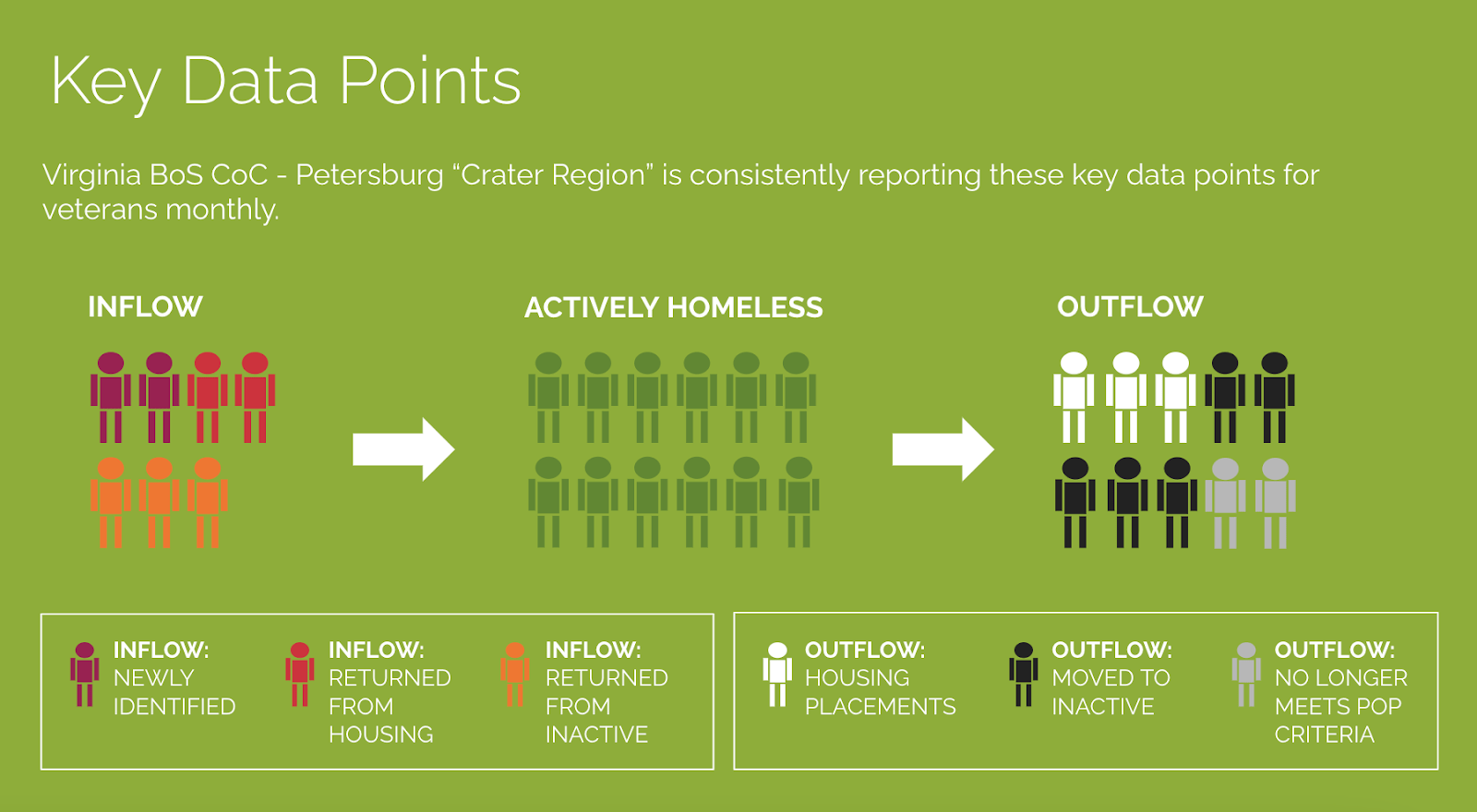
When Crater Region first began their work with Built for Zero, they knew they had some obstacles to gathering timely, accurate, and actionable data for all veterans experiencing homelessness in their community. Not all of the homeless service providers were entering data into their Coordinated Entry system, meaning that they could not maintain an accurate count of the number of veterans on their by-name list.
“In the beginning, it was really about data quality and making sure we were capturing all veterans that were experiencing homelessness and communicating about them,” Holmes said.
Through purposeful relationship-building with local VA and Supportive Service for Veteran Families providers, the team expanded the conversation around the necessity of real-time data and trained more people to be able to accurately report their numbers. By September 2020, the team had created a system that ensured quality data on every veteran experiencing homelessness. This data enabled them to understand who was moving out of homelessness, who was entering into it, and who was remaining on the list.
Once all providers contributed to the by-name list, the team was better able to triage clients and lower their numbers, working together to prevent clients from becoming homeless to begin with.
“To be on the same page and providing the same information to the community was our first challenge,” Holmes noted. “It was a lot of work, but we were able to do it.”
Recognizing the need for increased capacity around data quality, In August 2020, the Crater Region team utilized local funding to bring onboard an AmeriCORPS VISTA position to help track clients as they moved into housing or out of the system. Through Jackie Kent’s work, the team increased their overall capacity and quality of the data they collected.

USING DATA TO REDESIGN CRATER REGION’S HOMELESS RESPONSE AND TARGET RESOURCES
Covid-19 Response
With quality, real-time data coming in on all of the veterans experiencing homelessness in the Crater Region, the team was able to better leverage all available funding and resources — particularly those that became available during the Covid-19 pandemic.
“Since 2017, for the Crater Region, we have struggled with sheltering those who are homeless — just not having that consistent shelter to provide and follow-up,” Holmes said. “The CARES Act allowed us to provide motel and hotel shelter for people, and we were then able to have that direct contact with them to problem-solve and secure permanent housing.”
Refusing to let a crisis go to waste, everyone in the community endeavored to creatively utilize resources and ensure no stone was unturned in trying to get people into housing. They began using diversion tactics to keep people from entering homelessness, while also making use of available rent and mortgage relief funding. “Even though Covid has hit us hard, we have been able to leverage that and benefit from that,” Holmes said.
Case Conferencing
In another strategic redesign of their system, the Crater Region team attended Built for Zero’s first ever Case Conferencing Summit in November 2020 and immediately implemented the action-oriented strategies they learned there to enhance their case conferencing practice. The many organizations that composed the community’s “command center” embraced an integrated approach to house veterans, while also pulling in more people on the team to help with data and system changes.
These changes resulted in an acceleration in housing places for not only veterans, but people in other populations experiencing homelessness in the region. As their Built for Zero coach Smith noted, “Case conferencing changed the way they prioritized their conversations in meetings. They began giving not just updates, but action steps.”
While some teams have separate meetings to discuss only their veteran clients experiencing homelessness, the Crater Region brought all providers together, whether they focused on veterans or not, in one larger case conferencing meeting.
“I think it is beneficial to have everyone at the table, whether you provide veteran services or not,” said Holmes. “We were all on the same page as far as Coordinated Entry and access to services, and it makes a big difference when you are speaking the same language to all those experiencing homelessness in a community.”
This has ultimately garnered increased buy-in for the shared goal across the community of ending homelessness.
“We have increased our members and partners on our weekly calls from a year and a half ago,” Holmes said. “Every Wednesday everyone joins and participates and shares in our weekly goals.”
The Crater Area Coalition on Homelessness is a membership organization that meets every other week to bring community members together to address issues surrounding homelessness. As they expanded their case conferencing meetings and shared more resources, even more people wanted to be involved.
“That gave people the buy-in and excitement to be part of the conversation and to share their thoughts and ideas,” Holmes said.
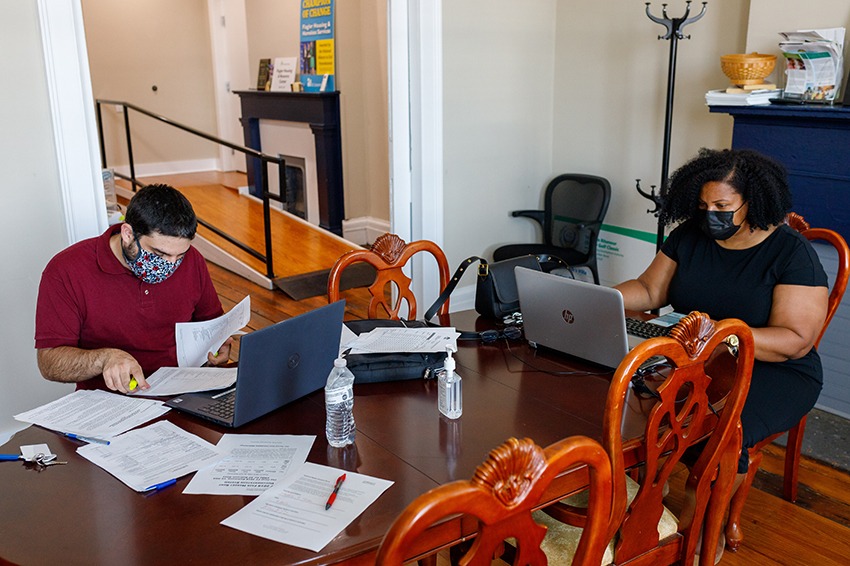
What’s Next
PROTECTING ZERO
After reaching functional zero for their veteran population, Crater Region is working to sustain their progress and expand their work to chronic homelessness.
Through the support of continued funding for their AmeriCORPS VISTA and CoC Coordinator positions, they hope to maintain proactive outreach to community partners and landlords as they scale their efforts to additional populations.
The team is determined to sustain their progress, despite barriers that may be ahead. As Holmes notes, “We are looking at the eviction moratorium, as probably everyone in the nation in homeless services, as we are going to see an increase in homelessness.” But with collective effort, a solid system, and real-time, by-name data, the community believes their goals are possible.
“You don’t have to be a homeless service provider or have money to put someone in a home,” said Holmes. “We all play a part in ending homelessness.”

Watch how they reached functional zero
Watch Erica Holmes, Director of Program Operations at St. Joseph’s Villa., share how her community reached functional zero for veteran homelessness in this HISTORY® video by our Built for Zero partners at Rocket Mortgage.
Timeline
2019
- May: Crater Region joins Built for Zero Collaborative
- October: Team attends the Built for Zero Learning Session and shifted improvement focus to data quality buy-in
2020
- Spring: Crater Regions enacts and develops COVID-19 response, capitalizing on expanded shelter capacity due to Q&I hotels to engage people experiencing homelessness
- July: All providers integrated into the Crater Region Coordinated Entry System (CES)
- August: Crater Region brings AmeriCorps VISTA role onboard to accelerate progress toward quality data
- September: Reached quality data on veteran homelessness
2021
- February: Crater Region reaches functional zero for veteran homelessness
Who was on the team?
Community Lead:
Erica Holmes
Director of Program Operations, St Joseph’s Villa
Data and HMIS Lead:
Jackie Kent
AmeriCorps VISTA, St Joseph’s Villa
Veteran Improvement Team:
Kristin Dibler
Prevention and Diversion Case Manager, St Joseph’s Villa
Amanda Browder
Grants Manager, Flagler Housing & Homeless Services, St. Joseph’s Villa
Keke Cody
Operations Supervisor, Supportive Housing & Homeless Services, CCC
Brooke Pendleton
HCHV Program Coordinator, Hunter Holmes McGuire VAMC
Matt Leslie
VVFS, Virginia Dept of Veteran Services
Rashad Webb
VSH, SSVF
Sharonita Cousin
VSH, SSVF
Laquisha Roach
Supportive Services Program Manager, VSH, SSVF
Ashley Collins
Supportive Services Housing Case Manager, VSH, SSVF
CoC Champion Lead:
Ara Mendoza
CoC Program Coordinator, Division of Housing, Virginia Department of Housing and Community Development
Built for Zero Coaches:
Shantae Smith and Garen Nigon
